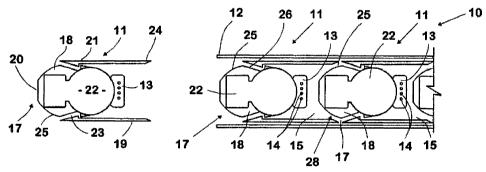Note: Claims are shown in the official language in which they were submitted.
12
CLAIMS
1. A weapon having a plurality of barrel assemblies (10, 30, 40) arranged in a
transportable pod (57) whereby the barrels (12) may be transported to and
directed at a selected target,
each barrel assembly (10, 30, 40) having
a plurality of projectiles (11, 35) arranged in-line within a barrel (12) and
which are
associated with discrete selectively ignitable propellant charges (37) and
ignition
means (16) for propelling the projectiles (11, 35) sequentially through a
muzzle
of the barrel (12),
characterised in that each projectile (11, 35) includes:
a trailing collar assembly (19, 31) captively mounted to a projectile body
(17, 42) and
extending rearwardly to engage a trailing projectile body (17, 42),
propellant in a rupturable high pressure chamber (13, 36) which exhausts to
the
barrel, such that after ignition
said propellant charge (37) expels high pressure gases into the barrel to fire
the
projectile (11, 35) from the barrel (12).
2. A weapon as claimed in claim 1, the transportable pod (57) having:-
a pod housing;
support means (58) for stably supporting the pod housing;
the plurality of barrel assemblies (10, 30, 40) supported in spaced
relationship within
said pod housing by respective swivel mounts (58), and
direction control means for selectively varying the relative alignment between
the
barrel assemblies (12, 20, 30) so as to selectively vary the relative
delivered
positions of projectiles (11, 35) fired from different barrels (12) at the
target.
3. A weapon as claimed in claim 2, wherein the direction control means permits
uniform pivoting of the barrel assemblies (10, 30, 40) so that the inclination
of
the axes of the barrel assemblies (10, 30, 40) relative to a pod axis may be
selectively and/or varied individual pivoting of each barrel assembly (10, 30,
40)
so that the inclination of each barrel axis relative to a pod axis may be
individually varied to enable a target position or individual target positions
relative to the pod (57) to be varied.
13
4. A weapon as claimed in claim 3 or claim 4, wherein the direction control
means
permits a controlled splaying of all barrel assemblies (10, 30, 40).
5. A barrel assembly (10, 30, 40) for a weapon, including:
a barrel (12) and
each barrel assembly (10, 30, 40) having
a plurality of projectiles (11, 35) arranged in-line within a barrel (12) and
which are
associated with discrete selectively ignitable propellant charges (37) and
ignition
means (16) for propelling the projectiles (11, 35) sequentially through a
muzzle
of the barrel (12),
characterised in that each projectile (11, 35) includes:
a trailing collar assembly (19, 31) captively mounted to a projectile body
(17, 42) and
extending rearwardly to engage a trailing projectile body (17, 42),
propellant in a rupturable high pressure chamber (13, 36) which exhausts to
the
barrel, such that after ignition
said propellant charge (37) expels high pressure gases into the barrel to fire
the
projectile (11, 35) from the barrel (12).
6. A barrel assembly as claimed in claim 5, wherein the trailing collar
assembly
(19, 31) engages over a complementary nose portion (25) of the trailing
projectile body (17, 42), to thereby form a low pressure chamber (15, 33, 33')
between the projectile and the adjacent trailing projectile (11).
7. A barrel assembly as claimed in claim 6, wherein the rupturable high
pressure
chamber (13, 36) exhausts to the low pressure chamber (15, 33, 33') formed
with the adjacent trailing projectile (11, 35), such that after ignition
said propellant charge (37) expels high pressure gases into the low pressure
chamber (15, 33, 33') to fire the projectile (11, 35) from the barrel (12).
8. A barrel assembly (10, 30, 40) as claimed in claim 5, wherein the high
pressure
chamber (13, 36) of each projectile (11, 35) is integrally formed with the
trailing
collar assembly (19, 31).
9. A barrel assembly (10, 30, 40) as claimed in claim 5, wherein the trailing
collar
(19, 31) of each projectile (11, 35) wedges against a complementary shaped
14
nose portion (25) of the trailing projectile body (17, 42) to thereby effect a
wedge
type seal between the rear end of the trailing collar assembly (19, 31) and
the
leading face of the trailing projectile body (17, 42).
10. A barrel assembly (10, 30, 40) as claimed in claim 9, wherein the wedging
configuration formed in the trailing end of the collar (19, 31) is a shallow
wedge.
11. A barrel assembly (10, 30, 40) as claimed in claim 5, wherein the collar
(19, 31)
is mounted for limited axial movement relative to the projectile body (17, 42)
and
the leading end of the collar (19, 31) is formed with an annular sealing face
engageable with a trailing sealing face formed on the projectile body (17,
42).
12. A barrel assembly (10, 30, 40) as claimed in claim 11, wherein said
trailing
sealing face and the annular sealing face are complementary part-conical
sealing faces.
13. A barrel assembly (10, 30, 40) as claimed in claim 5, wherein the rear end
of the
trailing collar assembly (19, 31) expands into operative sealing engagement
with
the barrel (12).
14. A barrel assembly (10, 30, 40) as claimed in claim 5, wherein the high
pressure
chamber (13, 36) includes a port or ports for exhausting the high pressure
gases
to the barrel.
15. A barrel assembly (10, 30, 40) as claimed in claim 5, wherein the ignition
means
(16) includes an electrically triggered detonator.
16. A barrel assembly (10, 30, 40) as claimed in claim 5, wherein ends of the
trailing
collar assembly (19, 31) having sealing angles sufficiently blunt as to resist
outward splaying into sealing engagement with the barrel (12).
17. A stackable projectile for barrel assembly according to any one of claims
to 16.
15
18. A projectile stack for a barrel assembly according to any one of claims
to 16.
